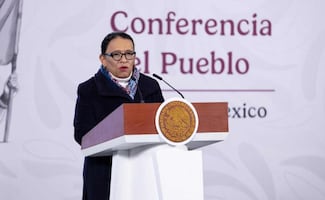Más Información

Sheinbaum rechaza discurso antimigrante de Trump; México mantiene postura firme en defensa a connacionales, afirma

Raúl Rocha se negó a ir a la FEMDO y quiso audiencias vía zoom; le anulan criterio de oportunidad a dueño de Miss Universo

“Entraron a mi casa durante la persecución”; vecino narra irrupción policial tras balacera en la Cuauhtémoc
The International Monetary Fund on Friday boosted its flexible credit line with Mexico to US$88 billion in a bid to support Latin America's No. 2 economy, whose currency has been battered by global volatility.
The fund said it canceled a previous flexible credit line, which was for US$67 billion and approved on November 26, 2014. The new credit line will last for two years, the fund said.
Mexico's macroeconomic policies "remain very strong," but there are risks given global market volatility, David Lipton, IMF First Deputy Managing Director and Acting Chair said in a statement.
Mexico's peso was little changed following the announcement.
Mexico has been one of the most orthodox adherents among emerging markets to IMF doctrine, such as a freely floating currency, and only Colombia and Poland have received similar credit lines.
But by offering the most liquid emerging market assets, Mexico has seen its currency become a proxy bet on risk in general, so when global sentiment turns sour, Mexico's peso is punished for other countries' economic sins.
A collapse in oil prices has crimped the flow of dollars into the central bank's coffers from crude sales by state oil company Pemex. The bank does not project building reserves this year.
After the announcement, Mexico's central bank said in a statement that the country's foreign currency commission considered requesting a credit line to be timely given external risks.
Mexico's peso has been pummeled since late 2014 amid the drop in oil prices and concerns about the global economy. The peso is down over 7 percent in May and it is on track to post its biggest monthly loss in four years after concerns about a U.S. interest rate hike hammered riskier assets.
Alberto Ramos, an economist at Goldman Sachs, said the bigger credit line would give Mexico "extra firepower" if it needs to defend the peso without worrying about depleting reserves.
Mexican central bank reserves fell by nearly US$19 billion since early last year to US$177.3 billion as oil prices slumped and the central bank sold dollars to support the weakening peso.
Foreign investors hold around 2 trillion pesos (US$109 billion) of local currency debt, and a stampede for the exits could sink the peso.
The peso has been the second worst performer of the 36-most traded currencies in May behind the South African rand even though Mexico's economy is chugging along better than other emerging markets.
Noticias según tus intereses
[Publicidad]
[Publicidad]











